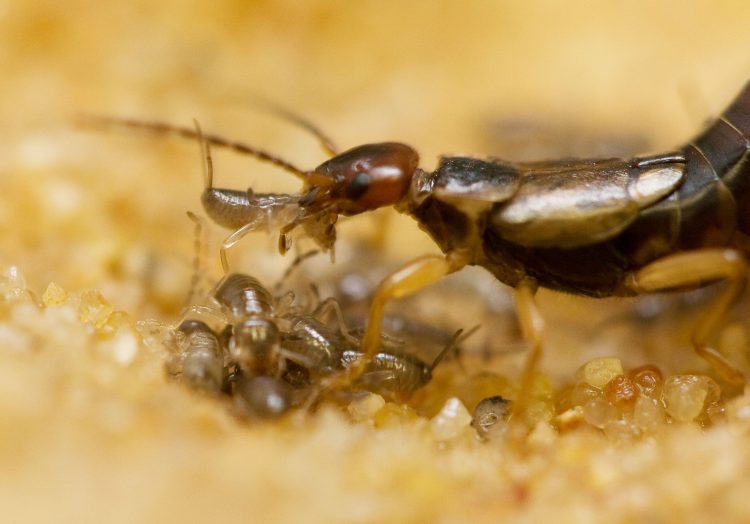Sibling cooperation in earwig families provides clues to the early evolution of social behavior

A female European earwig both cleans and transports her offspring photo/©: Joël Meunier, JGU
Looking at the question of how social behavior has developed over the course of evolution, scientists from the universities in Mainz and Basel have gained new insights from the study of earwigs. “Young earwig offspring don't simply compete for food.
Rather the siblings share what is available amongst themselves, especially when the mother is absent,” explained Dr. Joël Meunier of the Evolutionary Biology section of the Institute of Zoology at Johannes Gutenberg University of Mainz (JGU). The team of biologists from Mainz University and the University of Basel investigated the interactions between siblings of the European earwig (Forficula auricularia).
To date, insects have been only little studied with regard to cooperative behavior between siblings, except in the case of eusocial species, such as bees and ants. The European earwig provides, as the research project shows, valuable clues to the origins of social behavior patterns.
The animal kingdom has an unbelievable diversity of forms of social life. These encompass situations such as the temporary aggregation of single individuals to social communities based on the division of labor. For evolutionary biologists this poses question of how these ubiquitous social life forms emerged despite the accompanying disadvantages of competition and conflict among group members. When it comes to birds, for example, the competition among siblings is often so fierce that some of the younger animals die.
“In the case of earwigs, we have a system that closely resembles the primitive conditions of family life,” said Jos Kramer, a doctoral candidate on Meunier’s team. In fall, female earwigs lay on average 40 to 45 eggs and stay over the winter with them. The mothers watch the eggs, keep them clean by licking off fungi, for example, and carry them back and forth in the nest. Once the young, the so-called nymphs, emerge, they stay in the nest for few weeks with their mothers, even if the presence of this latter is no longer necessary for their survival. Indeed, the nymphs could leave the family unit soon after emergence and take care of themselves from then on.
These sub-social forms of life provide the ideal field of research for investigating under what conditions the advantages of cooperation in a family unit outweigh the disadvantages. For this purpose, the scientists from Mainz and Basel provided 125 earwig families with dyed pollen and observed if and how the food was divided amongst the siblings.
“We found that siblings behave cooperatively and share food and that this behavior occurs much more frequently when the mother is not present and is not feeding her offspring herself,” stated Meunier. This may at least partly explain why mobile offspring stay with the family group despite the disadvantages associated with this. In addition, this insight provides an important clue to the early development of social behavior. The previously largely ignored aspect of sibling cooperation is possibly one of the key factors that promoted the transition from solitary to social life.
Images:
http://www.uni-mainz.de/bilder_presse/10_zoologie_ohrwuermer_familie.jpg
A female European earwig (Forficula auricularia) with her young
photo: Joël Meunier
http://www.uni-mainz.de/bilder_presse/10_zoologie_ohrwuermer_mutter_nymphen.jpg
A female European earwig both cleans and transports her offspring
photo: Joël Meunier
Publication:
Joachim Falk et al.
Sibling Cooperation in Earwig Families Provides Insights into the Early Evolution of Social Life
The American Naturalist, 11 February 2014
DOI: 10.1086/675364
Further information:
Dr. Joël Meunier
Evolutionary Biology
Institute of Zoology
Johannes Gutenberg University Mainz (JGU)
D 55099 Mainz, GERMANY
phone +49 6131 39-27852
fax +49 6131 39-27850
e-mail: meunier@uni-mainz.de
http://www.bio.uni-mainz.de/zoo/evobio/322_ENG_HTML.php
http://www.bio.uni-mainz.de/zoo/evobio/217_DEU_HTML.php ;
http://www.jstor.org/stable/10.1086/675364 (Article)
Media Contact
All latest news from the category: Life Sciences and Chemistry
Articles and reports from the Life Sciences and chemistry area deal with applied and basic research into modern biology, chemistry and human medicine.
Valuable information can be found on a range of life sciences fields including bacteriology, biochemistry, bionics, bioinformatics, biophysics, biotechnology, genetics, geobotany, human biology, marine biology, microbiology, molecular biology, cellular biology, zoology, bioinorganic chemistry, microchemistry and environmental chemistry.
Newest articles

Properties of new materials for microchips
… can now be measured well. Reseachers of Delft University of Technology demonstrated measuring performance properties of ultrathin silicon membranes. Making ever smaller and more powerful chips requires new ultrathin…

Floating solar’s potential
… to support sustainable development by addressing climate, water, and energy goals holistically. A new study published this week in Nature Energy raises the potential for floating solar photovoltaics (FPV)…

Skyrmions move at record speeds
… a step towards the computing of the future. An international research team led by scientists from the CNRS1 has discovered that the magnetic nanobubbles2 known as skyrmions can be…





















